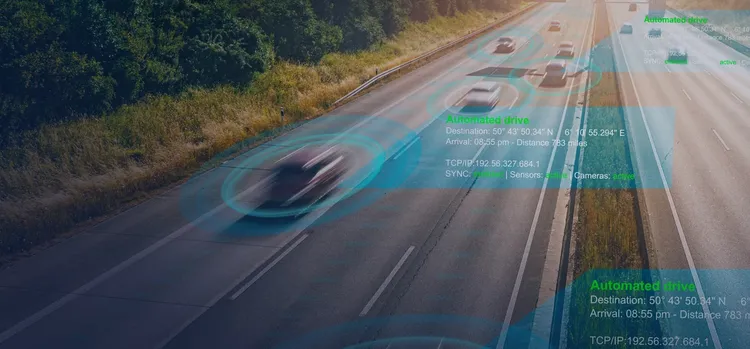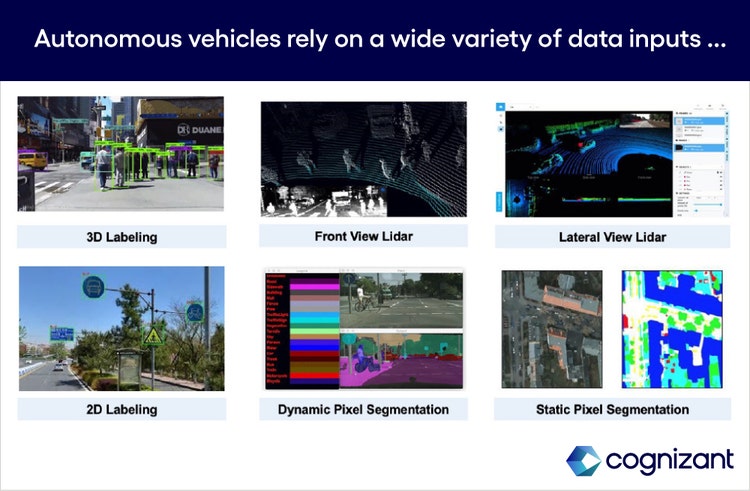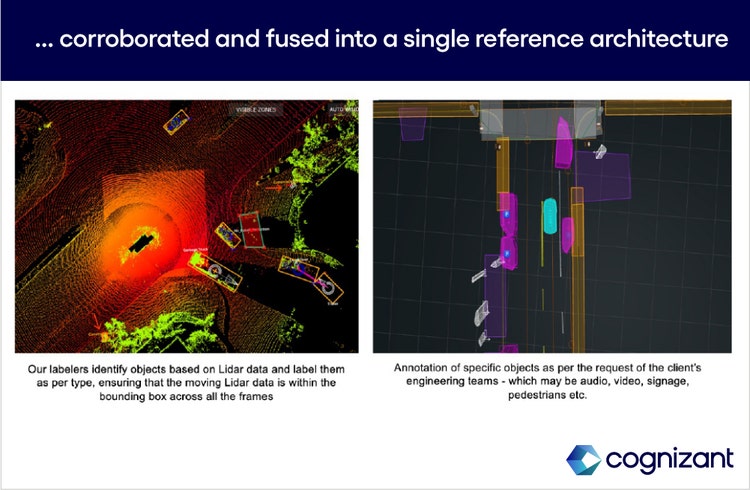
Mapping the future in a driverless world
<p><br> July 25, 2025</p>
Mapping the future in a driverless world
<p><b>High-definition mapping is a critical enabler for creating a driverless world of autonomous vehicles – and training AV algorithms with these hyper-detailed maps is the other crucial step.</b></p>
<p>According to research firm Gartner, an additional <a href="https://www.gartner.com/document/3990904?ref=solrrqp\&refval=367036230" target="_blank" rel="noopener noreferrer">2.5 million autonomous vehicles will hit the market by 2029</a>. But how soon you’ll see AVs in your business ecosystem depends on how quickly automakers can perfect high-definition (HD) mapping, a critical enabler of safe and secure AV operations.</p> <p>HD mapping is a colossal undertaking that employs advanced mapping technologies to generate detailed and accurate representations of the real-world environment. It requires the continuous collection and analysis of complex data points from disparate sources owned by various stakeholders within the connected mobility ecosystem. Therefore, one of the biggest challenges in building HD maps is maintaining a near-perfect degree of real-time accuracy, without which AV users may become lost, disabled, or worse.</p> <h4>Understanding the data that informs high-definition maps</h4> <p>HD maps are more accurate than satellite-based Global Positioning Systems (GPS). An augmented digital twin of the physical world, they provide detailed and contextual models of the operating environment that assist AVs in avoiding mistakes, like <a href="https://www.autoweek.com/news/green-cars/a37114603/tesla-fsd-mistakes-moon-for-traffic-light/" target="_blank" rel="noopener noreferrer">interpreting the moon as a yellow traffic light</a>.</p> <p>In our personal lives, we have become accustomed to traditional maps augmented by advanced metadata that allows them to incorporate points of interest like local restaurants or alerts like road-work warnings. However, HD maps include more advanced insights and plot data in more granular resolutions that capture as little as 1.9 inches (or roughly 5 centimeters) of real-world space.</p> <p>This is achievable through data inflows from a variety of sources, including:</p> <ul> <li><b>Light Detection and Ranging (LiDAR) sensors:</b> Remote sensing technology that uses lasers to view the road environment in 3D, including features like road surface shape, texture and elevation.<br> <br> </li> <li><b>Cameras:</b> Multi-angle cameras affixed to the AV generate visual data about the road environment, including lane markings and traffic signs. This information, combined with LiDAR sensor insights, can be used to deliver vital 360-degree context to the vehicle.<br> <br> </li> <li><b>GPS:</b> Satellite signals accurately locate the HD map data on Earth.<br> <br> </li> <li><b>Radar: </b>Radio waves sense and measure the distance, angle and velocity of obstacles around or in the direct pathway of the AV.</li> </ul>

#
<p><span class="small">Figure 1</span></p> <p>Many companies are racing to perfect HD mapping for the AV sector. A recent report from Allied Market Research notes a <a href="https://www.businesswire.com/news/home/20230125005629/en/HD-Map-for-Autonomous-Vehicles-Market-Report-2022-As-Autonomous-Vehicles-Advance-Map-Requirements-Advance-With-Them---ResearchAndMarkets.com" target="_blank">$3.7 billion valuation for the HD mapping market</a>, expected to leap to $66.1 billion by 2035. But the most promising initiatives in the market today are focused on making HD maps easier to build and use.</p> <p>Zenzic, the UK hub organization for self-driving vehicle development, and Ordnance Survey (OS), Great Britain's National Mapping Agency, have taken the lead in advocating for greater collaboration between government authorities and various industries to establish a centralized, authoritative global data source for HD mapping. Their <a href="https://zenzic.io/case-studies/geodata-report/" target="_blank">published Geodata report</a> offers analysis and recommendations for common approaches and data standards in self-driving vehicle testing. </p>

#
<p><span class="small">Figure 2</span></p> <h4>Using machine learning to train the vehicle</h4> <p>Building the HD map is challenging, but it is even more difficult to train the vehicle — or, more accurately, its underlying technology. Using machine learning (ML), AVs are taught how to read and respond to data points on the map, understand instructions and accurately contextualize new data. As a result, the vehicles can constantly perceive and predict changes in the surrounding environment.</p> <p>This includes developing the ML models to allow the vehicle to accurately distinguish between stationary and dynamic objects, such as traffic signs and pedestrians, as well as sudden, unexpected objects or events like debris or a road closure.</p> <p>These models must also be able to identify the optimal response to each of these objects or events within the vehicle’s immediate environment. For example, the ideal reaction is based not just on the type of object the vehicle encounters, but also other factors, such as time of day, weather conditions and vehicle speed. When you consider how many scenarios and variables these models must be trained to respond to, it is easy to see how vast and complex that underlying data set must be — and how quickly the model must be able to process that data to identify and execute the optimal action.</p> <p>Building these algorithms requires thousands of hours of careful and diligent training led by highly skilled engineers who manage the end-to-end process closely. Before an AV can take to a real-world road, it must undergo millions of (virtual) miles of simulated driving and thousands of hours of supervised operation. These engineers help the algorithms understand the environment and make correct decisions, root-cause problems that arise and design new failsafe mechanisms as needed.</p> <h4>Generative AI to accelerate model development</h4> <p>With the explosion of Gen AI, new scenarios can be quickly simulated using base models. For example, a driving scenario built with summer data can be rapidly adapted to simulate rain and snow conditions. Similarly, new scenarios such as chemical spills, accidents, and road closures can be quickly modeled and tested. Careful selection of edge cases—such as unusual weather or pedestrian behavior—enhances the robustness of the simulations. Synthetic data generation is a game changer for enhancing ML models and significantly boosts the safety and reliability of autonomous vehicles.</p> <h4>Keeping up with constant change</h4> <p>The world around us moves at exponential speed. As a result, AV teams face the unique challenge of building new technology for an ever-shifting and -evolving environment. That’s why they continually enhance and expand HD mapping capabilities using the abundance of first-hand data captured by vehicles as they travel, as well as data from third-party sources.</p> <h4>Finding your place in an AV world: Three steps toward the future of mobility</h4> <ol> <li><b>Set a clear roadmap. </b>Even though the AV landscape is expected to change dramatically in the next several years, companies must create a specific plan for how they intend to build maturity and scale operations. This includes identifying partners the business wants to engage, developing technologies and capabilities needed to achieve the vision, and defining milestones to measure progress over both the short and long term.<br> <br> </li> <li><b>Engage a partner ecosystem.</b> Developing and operating AVs at scale requires a vast network of strategic partners that share the organization’s vision for the future of mobility. This includes partners that bring specific digital, regulatory, testing and CX capabilities to the ecosystem. Because this field is evolving so fast, it is important that these partners can rapidly change to meet new requirements as they arise and that they can effectively scale to meet demand.<br> <br> </li> <li><b>Choose a technology partner with industry expertise.</b> In addition to engaging a complete partner ecosystem, companies must pay special attention to selecting a technology partner that has extensive experience not just in data analytics and AI/ML model development, but AV mapping specifically. Ideally, this partner would bring best-in-class processes, tools and technologies to the engagement, allowing the organization to maximize productivity and reduce risk. The latest advances in gen AI demand a partner that can provide high-quality training datasets for complex use cases, along with testing teams agile enough to adapt to evolving simulations and scenarios.<br> </li> </ol> <h4>Charting your course forward in a driverless world</h4> <p>Much work is needed before we see driverless tires hit the road at scale. From creating hyper-detailed mapping services to training algorithms across millions of miles and thousands of hours, many steps remain to ensure the safety and security of driverless vehicles.</p> <p>As the world’s automakers, public organizations and AV start-ups continue to collaborate to improve HD mapping standards, driverless vehicles will be coming to a road near you with more intelligence and safety built in.</p> <p><i>To learn more about </i>how<i> Cognizant is helping the autonomous vehicle market and digital disruptors, please visit our </i><a href="https://www.cognizant.com/us/en/services/business-process-services/digital-disruptors" target="_blank" rel="noopener noreferrer"><i>Digital Disruptors</i></a><i> knowledge hub or </i><a href="https://www.cognizant.com/us/en/services/business-process-services/digital-disruptors#contact-us" target="_blank" rel="noopener noreferrer"><i>contact us</i></a><i> to schedule a consultation.</i></p> <p><i>This article was written by Ramakrishna Mulukutla, Assistant Vice President and Kanti Kopalle, Vice President in Cognizant’s Intelligent Operations and Automation Business Unit.</i></p>
<p>We’re here to offer you practical and unique solutions to today’s most pressing technology challenges. Across industries and markets, get inspired today for success tomorrow.</p>
